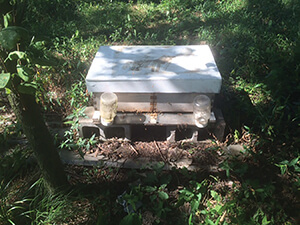
A few years ago, we had a series of experiments with two attempts at 2-queen colonies. The first experiment involved a long hive. The idea was to have one colony on one side and a second colony on the other side with a shared space in the middle. It worked out quite well for the bees. They filled the middle space with shared honey, did not fight and produced a full deep super of honey in the central shared compartment. The middle compartment was bracketed by vertical queen excluders in a frame. Shallow supers were placed on top of this arrangement, over the middle compartment. It worked but in my comb honey operation, I did not make comb honey in the central shared space.
In hindsight, the obvious thing to do would have been to make the central shared chamber for comb honey production. This year that will be the goal for one of my hives. I will load the sides with nucleus colonies and put frames with comb honey foundation in the center, thereby taking out individual frames of comb honey as they are made. The major problem with that concept in the beginning was my failure to realize that once the colonies had a full deep hive body equivalent of honey in storage, along with a full shallow super on top, they were no longer concerned with making additional winter storage. In two years, I managed to harvest only three supers from this very large colony.
Our second attempt was the conjoined hive body configuration where two deep hive bodies were put together. The bees did fine. The two-queen colony overwintered better than any of my single colonies. The only problem was production. The two-queen colony produced three shallow supers of comb honey. This is about average for my apiary. Why use a two-queen system with the associated management difficulties if the reward is no better than that of a single colony? The only reason would be that both of these long colonies allowed the bees to overwinter better. When the queens were separated and the bees accepted my two-queen system with the shared space, the advantage was healthier bees in the spring. However, there was no production advantage.
The double stack two-queen system with one colony on top, another on the bottom and shared space in the middle is the most productive double-queen system. The horizontal two-queen systems produce about as much honey as a single colony. My experience with these long hives has had an effect on this beekeeper. Long hives are interesting. It is a more natural configuration than the standard Langstroth hive. It has been a desire of mine to keep bees in a long hive for several years. So the time has come to consult one of the foremost U.S. experts on long-hive honey production.
Dr. Wyatt A. Mangum has been keeping bees in long hives (top-bar hives) for more years than anyone else I know (25 +). He is a strong proponent of keeping bees in long horizontal colonies. In his writings he points out that bees in horizontal hives often survive winter better than those in the standard box hive. My experiments with two-queen systems seem to confirm his opinion. Only one factor has kept me from looking more closely at Dr Mangum’s top-bar long hives. It just did not seem to be the best system to use with square or rectangular comb honey boxes. After all, his combs are trapezoidal. Would there not be waste?
There is waste in cutting comb honey out of standard supers. The medium depth “Illinois” boxes are the wrong size for comb honey production. Only deep framed combs or shallow frame combs will cut to fit the plastic containers without a lot of waste. A top bar without the frame, with a comb hanging down would be a decided advantage where packing the honey is concerned. After looking into Dr. Mangum’s book Top Bar Hive Beekeeping: Wisdom & Pleasure Combined, I agree with his precepts and conclusions. Comb honey production in a long hive is a good idea.
Much of the remainder of this article will reference his extensive work on top-bar hives and comb honey production. I strongly suggest you get a copy and read his text before proceeding with suggestions within this paper. You should also know there is a more detailed book of Dr. Mangum’s that is an updated version of the one I have. A periodical on this subject has limitations. The entire …


